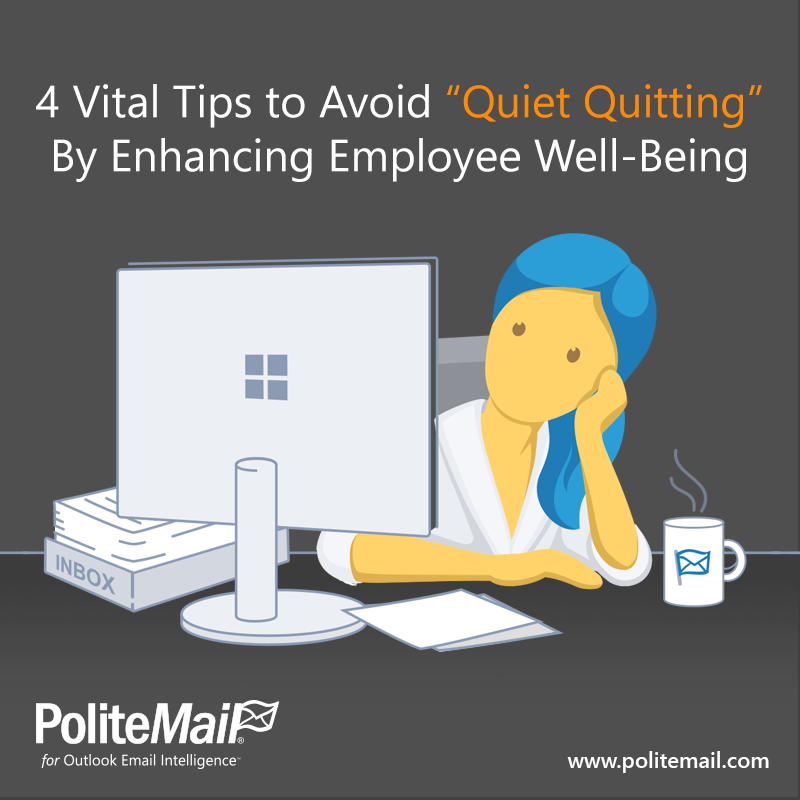 Employee well-being is essential to the success of an organization. Employees who feel valued are more productive, engaged, and motivated. Unfortunately, Gartner finds that while 82% of employees want to be viewed by their organization as a person and not just an employee, only 45% believe they’re seen this way.
Employee well-being is essential to the success of an organization. Employees who feel valued are more productive, engaged, and motivated. Unfortunately, Gartner finds that while 82% of employees want to be viewed by their organization as a person and not just an employee, only 45% believe they’re seen this way.
Employees may become disengaged if a company neglects their well-being and sometimes silently quit their jobs. Silent quitting, popularly referred to as quiet quitting, is when employees disengage from their work and become less productive — putting in the bare minimum to get by. Although quiet-quitting can happen in an office, quiet quitting has becoming a larger conversation since work-from-home and hybrid arrangements have become normalized.
Quiet quitting can be detrimental to an organization. By prioritizing employee well-being, companies can minimize quiet quitting. Here are some tips to help your people feel valued and supported at work.
- Offer benefits that support work-life balance.
Work-life balance has been a buzzword for years, but in the wake of the pandemic, flexible work has taken center stage. When feasible, flexible work arrangements like remote work or flex time can help employees balance their personal and professional lives. Standard flex-time arrangements let workers choose when to start and finish their days while observing core hours, such as 10 am to 4 pm.
The International Labour Organization reported that flexible work arrangements can help parents better manage non-work commitments, positively impact employee mental health, lower stress, and improve job satisfaction. Additionally, flextime benefits employers by reducing employee turnover, minimizing recruitment costs, and increasing productivity.
Employers should also encourage employees to take time off as needed and ensure reasonable workloads.
- Build a culture of trust among employees.
At its core, quiet quitting is an act of employee resistance that can occur for various reasons. Employees may feel that leadership has ignored their past concerns and ideas or perceive their contributions as unvalued. Whatever the case, a lack of trust negatively impacts employee loyalty and promotes quiet quitting.
Harvard Business Review (HBR) found that “Compared with employees at low-trust companies, 50% more of those working at high-trust organizations planned to stay with their employer over the next year, and 88% more said they would recommend their company to family and friends as a place to work.” When employees trust their employer, they are more likely to feel secure and willing to invest their time and effort into the company’s success.
- Invest in employee wellness.
It’s also important to prioritize employee wellness. In 2021, HBR found that 68% of Millennials and Gen Zers have left roles for mental health reasons. Since quiet quitting often occurs when employees mentally check out due to stress, burnout, or other health-related issues, employee wellness programs are a direct antidote to silent quitting. Invest in employee wellness benefits like mental health and counseling support, outdoor recreation benefits, gym or exercise program memberships, and healthy food education programs.
- Recognize and reward employees.
According to Gallup’s analysis, only one in three workers in the U.S. strongly agree that they received recognition or praise for doing good work in the past seven days. Employee recognition programs can address this by providing a structure for acknowledging employee contributions. And since employees who feel valued and appreciated are more likely to be engaged and committed to their job, employee recognition can significantly impact quiet quitting.
While you can consider tangible rewards like bonuses, promotions, or other monetary incentives, people often respond to intangible rewards like public recognition in an employee newsletter, appreciation emails, or one-on-one conversations about an employee’s positive impact on the organization.
Enhance employee well-being to reduce quiet quitting.
To enhance employee well-being and avoid quiet quitting, take care of your people. Offer benefits that support work-life balance, build trust among employees, support employee wellness, and recognize your employees’ work. You can improve employee well-being and reduce quiet quitting by putting your employees first.








